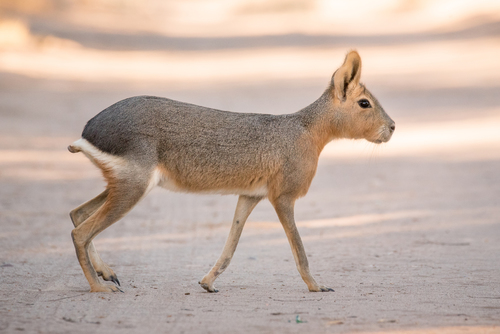
Patagonian mara
The Patagonian mara, with its long limbs and rabbit-like appearance, is a swift runner of the Argentine plains. Noteworthy for its monogamous bonds and social family groups, this large rodent constructs burrows for shelter. An intriguing blend of rabbit and deer features, it plays a vital role in its arid ecosystem.
5-10 years
Lifespan
7.71 - 15.88 kg
Weight
Length: 61 - 81 cm; Height: 30 cm
Size
Brown, Red, Cream
Color
3-6 months
Age of Sexual Maturity
75-78 days
Age of Weaning
Low
Aggression
Near Threatened
Conservation Status
Decreasing
Population Trend
Characteristics
The Dolichotis patagonum, commonly known as the Patagonian mara, is a large rodent native to the arid regions of Argentina. It exhibits a unique behavior of monogamous pair bonding and can often be seen in small family groups. The species is known for its long legs, which allow for swift running across the open plains. Patagonian maras have a complex social structure and are known to dig burrows for shelter.
Distribution Range of the Patagonian mara
Dolichotis patagonum, commonly known as the Patagonian mara, is native to the central and southern regions of Argentina in South America. It primarily inhabits areas in the Patagonian steppes and semi-arid regions of Argentina.
Patagonian mara's Habitat
Environmental Conditions
The Patagonian mara is adapted to live in arid and semi-arid environments. It is typically found in open grasslands, shrublands, and areas with sparse vegetation, which provide both the cover and food sources it needs. The climate in these regions is characterized by low precipitation, significant temperature variations between day and night, and frequent winds.
Ecological Niche
Patagonian maras are herbivorous, primarily grazing on grasses and other vegetation available in their habitat. They are well-adapted to the open landscapes of the Patagonian steppes, where their long legs and ability to run at high speeds help them evade predators. They have a unique social structure, often forming monogamous pairs and living in communal burrow systems. This ecological niche allows them to exploit the scarce resources of their environment effectively.
Copyright @ Nature Style Limited. All Rights Reserved.
 English
English